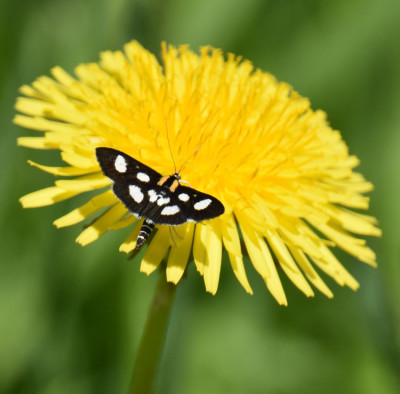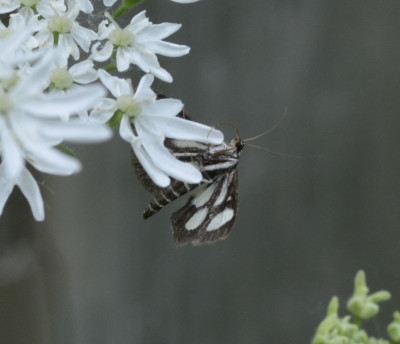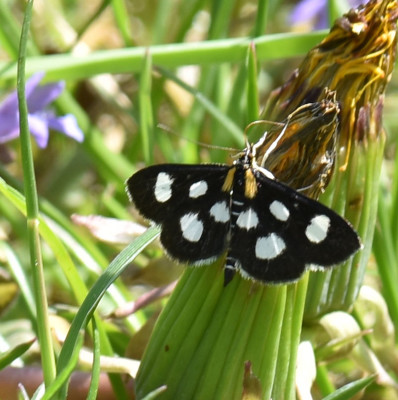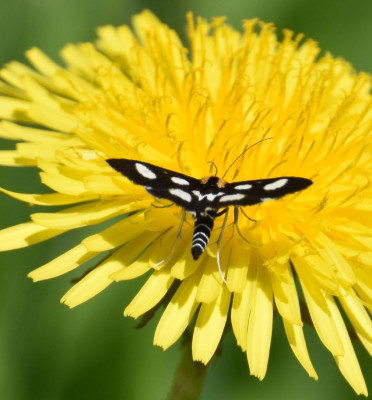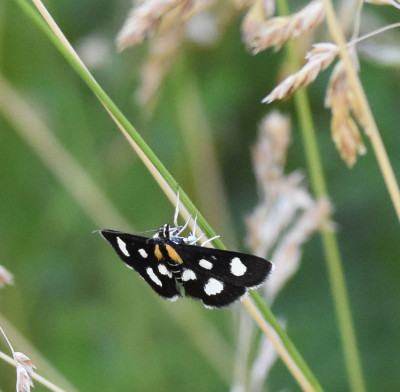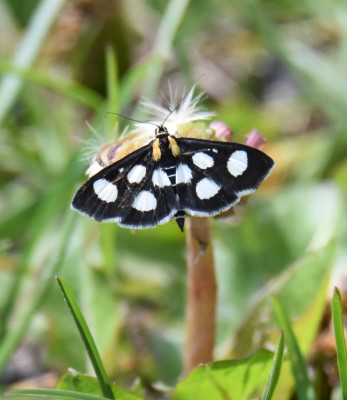I do like insects that have names that make sense. The White-striped Black Moth for example, is perfect. This one is almost perfect and the bit that makes it hard to remember is at least poetic: this moth is a White-spotted Sable. To me, “sable” reminds me of mink coats and I think of a dark brown colour. And when I look closely at this moth, I see that it actually is dark brown. So I guess the word Sable is appropriate.
What Is This Dark Brown Moth With Eight White Spots and Two Orange Stripes On the Neck?
Having now corrected the title, I’ll move on. These White-spotted Sable moths are quite common in June in the parks along the Credit River. They are probably quite common in other forest clearings, too! If you’ve seen them around, please share your sighting with a comment.
Like many moths, they seem to prefer to perch underneath leaves and along stems rather than right out in the open. This one had perched on the underside of a Cow Parsnip petal and was curving its proboscis up onto the flower. It looks to me like it’s only touching the petal though, not the centre of the blossom where presumably any nectar is. So I don’t know if it eventually moved or whether it was content with some dew or moisture on the surface of the petal.
Many insects seem to flock to the Cow Parsnip blossoms for either nectar or pollen. They are a native plant, although they look very similar to Giant Hogweed, so the parks do not intend to destroy them. Just as well for this little moth!
If you do get to see one of these moths face up, there are two distinctive orange marks along the body near where the neck or shoulders would be on an animal. I noticed this orange colour even when the moths were in flight although I couldn’t tell exactly where it was located on them while they were moving.
If It’s a Moth Why Am I Seeing It In the Daytime?
We tend to think of moths as night creatures and butterflies as day-time insects. Unfortunately, like the distinctions between vegetables and fruits, the moths and butterflies never agreed that there was a clear line between the two.
White-spotted Sables and White-striped Black moths are often seen in the daytime. The Sables like to visit flowers; This makes them especially noticeable.
It’s said that moths more often perch with their wings flat than butterflies but to be honest I’ve seen many, many open-winged butterflies perching from Monarchs to Mourning Cloaks and many of the dark-winged Skippers. I’ve given up and have a good field guide for each: The ROM Guide to the Butterflies of Ontario and the Peterson Field Guide to Moths of Northeastern North America.
Where Do White-spotted Sable Caterpillars Lurk?
According to the write up on BugGuide.Net, the young feed on Goldenrod. No wonder they are found throughout most of Canada!
I hope to see more of these moths again in June. Like Pandas and Penguins their black and white colouring appeals to me.
Related Reading
- What is this Black Moth with the White Stripe on Each Wing?
- A Luna Moth Emerges
- Milkweed Tussock Moth Caterpillars Munch Milkweed
- The Electric Blue Bodied Ctenucha Moth
Join In
Have you noticed some of these spotted moths visiting flowers in your neighbourhood? Please share your sighting with a comment.

